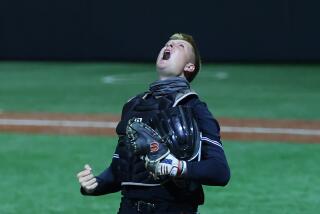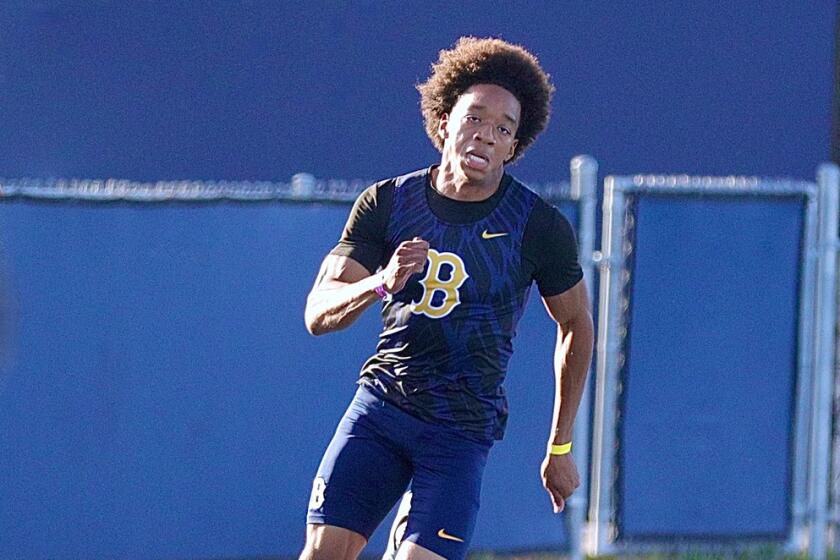Kris Bryant a not-so-secret weapon for San Diego in NCAA regional

- Share via
With all that has been said about Kris Bryant’s prodigious baseball talents — the tape-measure home runs, pitches he shouldn’t have been able to hit but did — he is also a scholar-athlete, a highly intelligent young man.
It must run in the family. Because Grandpa was certainly no fool.
From the time Bryant was 8 or so, college baseball’s most feared slugger recalls his grandfather awarding him $20 for every home run. The practice allowed Bryant to accumulate quite a bundle of Jacksons before the rewards stopped during his high school years.
“I was OK with it,” he says with a laugh. “I mean, I didn’t want to take all their money.”
Bryant had 22 home runs in his senior season at Las Vegas Bonanza High and 54 in his three years playing for the University of San Diego — including a scaled-back-metal-bat-era record of 31 in 58 games this season.
That would have been $1,520 in four years. But no one should worry about Bryant being strapped for cash. Next week, he is expected to be one of the first picks in Major League Baseball’s annual amateur draft, a designation that will earn him a seven-figure bonus.
First, though, he will try to help San Diego advance from the NCAA Division I regional at UCLA. The Toreros (35-23) open play Friday against Cal Poly (39-17) at 2 p.m. UCLA (39-17) faces San Diego State (31-29) at 6 p.m. The winner of the double-elimination regional advances to a best-of-three-games super-regional next week, which will probably start the day after Thursday’s draft.
Bryant could be in for an exciting next few days. “He’s a five-tool, off-the-charts guy,” San Diego Coach Rich Hill says, citing a player’s ability to hit for average, hit for power, run, throw and play defense.
An impressive athlete at 6 feet 5 and 215 pounds, Bryant moves well and shows a strong arm from third base. Hill says he has the speed and instincts to develop into a Gold Glove right fielder if a pro team takes him in that direction.
But swinging the bat is what shot him up the draft boards.
One of his home run blasts has already taken on legendary proportions. On a wet, foggy night in San Diego, in a game against St. Louis, Bryant hit a ball that reportedly cleared an 80-foot light tower in left field — a shot estimated to be at least 500 feet.
Bryant says he didn’t see where it landed. Hill says he can only assume the ball did actually land because it “disappeared into the night.”
“Now it’s to the point where Bigfoot was behind the fence and the Loch Ness monster was sighted that day in Mission Bay. One of those kind of things,” Hill says. “I don’t know that it cleared the light standards … but let’s just say it did. It could have landed anywhere.”
It’s an unwritten rule in baseball that a hitter should never admit to “getting all” of a pitch — in other words, hitting it as far as possible. But with that home run, Bryant just can’t help it.
“Yes, I got all of that one,” he says with an ear-to-ear grin. “I’ll remember that one forever.”
A strategy employed by UC Irvine might also stick with him. With two out, nobody on base and Bryant coming up to hit during a nonconference game this season, Anteaters Coach Mike Gillespie used four outfielders — one near each line and one in each gap. And it worked.
“Kris smoked one down the left-field line — it would have one-hopped the foul pole — and their guy is standing right there,” Hill says.
Other strategies to neutralize him haven’t fared as well. University of San Francisco pitching coach Greg Moore recalls a conversation with one of his pitchers after Bryant, during his freshman season, homered over the right-field fence on a one-ball, two-strike fastball that was supposed to be placed too far outside to hit.
“That ball needs to be off the plate,” Moore scolded. “It was,” the pitcher replied. “One ball?” Moore asked. “No,” said the pitcher. “Two and a half.” The catcher confirmed it.
Says Moore: “What could I say? Nobody does that.”
Bryant, who bats lead-off so that he gets as many at-bats as possible, doesn’t just hit home runs. He has a team-best .340 batting average and leads Division I players with 215 total bases, a .860 slugging percentage, 78 runs and 62 walks.
Hill, who has been a college baseball coach for nearly three decades, says Bryant is the best college hitter he has seen. Of course, he’s biased. Moore, who is not, says “the best and most dangerous. The quickest, most-sure hands.”
Three seasons ago, the metal bats college players used were scaled back and offensive numbers plummeted. The college record for home runs in a season is 48, and projections have been made that Bryant would have hit 50 or more with the old bats.
Bryant doesn’t offer any estimate; neither does Hill.
Moore, tongue planted firmly in cheek, offers a different kind of prediction: “He’d have been banned from the game.”
More to Read
Go beyond the scoreboard
Get the latest on L.A.'s teams in the daily Sports Report newsletter.
You may occasionally receive promotional content from the Los Angeles Times.











